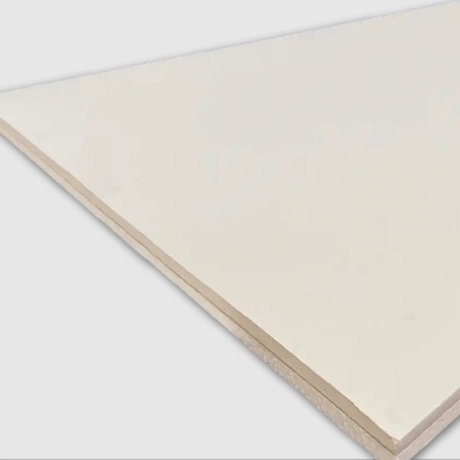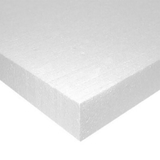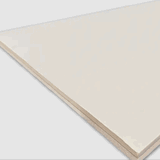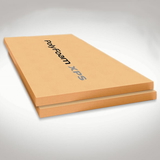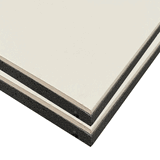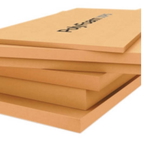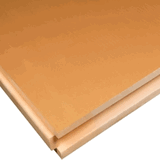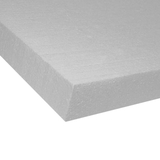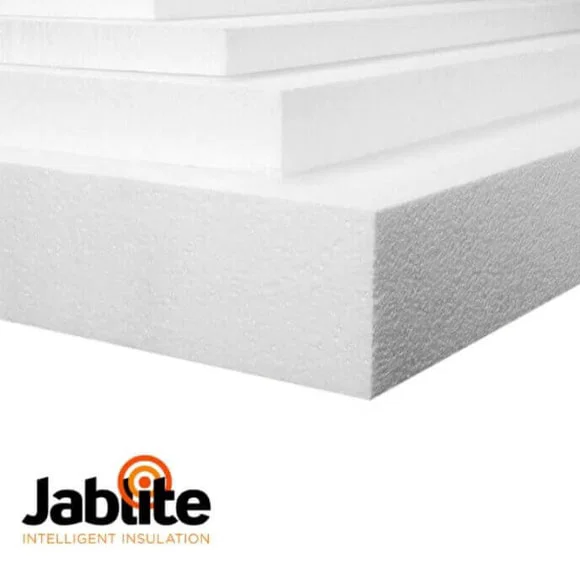- Blogs
- A Comprehensive UK Guide to EPS and XPS Polystyrene Insulation
A Comprehensive UK Guide to EPS and XPS Polystyrene Insulation

TLDR: Key Points
-
EPS vs. XPS: Expanded Polystyrene (EPS) is the familiar white, beaded foam material. Extruded Polystyrene (XPS) is a dense, smooth, and often coloured foam. Their distinct manufacturing processes result in different physical properties and applications.
-
The "Styrofoam" Name: In the UK, the term "Styrofoam" is a registered trademark for a specific brand of XPS insulation. However, it is commonly and incorrectly used to describe the white, beaded EPS found in packaging. This guide uses the correct technical terms to avoid confusion.
-
Performance and Use: XPS offers superior moisture resistance and compressive strength, making it the required choice for demanding applications such as below-ground insulation, inverted roofs, and floors subject to heavy loads. EPS is a highly cost-effective and versatile insulator suitable for walls, lofts, and floors installed above the damp-proof membrane.
-
Regulations: The use of both materials in construction must comply with UK Building Regulations. This includes meeting the thermal performance targets (U-values) set out in Approved Document L and adhering to specific fire safety standards relevant to their application.
-
Environmental Profile: Both materials are derived from petroleum. EPS generally has a lower embodied carbon footprint. While XPS historically used blowing agents with a high Global Warming Potential (GWP), UK manufacturers have transitioned to low-GWP alternatives. Recycling is possible for both, but it relies on specialised commercial collection services rather than local authority kerbside schemes.
Understanding Polystyrene Insulation: EPS, XPS, and the "Styrofoam" Name
Polystyrene is a synthetic polymer that has become an integral part of modern life, found in everything from disposable cutlery and CD cases to its most common form in construction: rigid foam insulation. In the building industry, two principal types of polystyrene foam are used: Expanded Polystyrene (EPS) and Extruded Polystyrene (XPS). Although they share the same base chemical, their manufacturing methods are fundamentally different, giving them distinct properties that make them suitable for very different applications.
A significant point of confusion, particularly in the UK, surrounds the term "Styrofoam". This is a registered trademark of the DuPont company for its range of XPS insulation products, which are typically blue in colour. However, colloquially, the name is often misapplied to the white, bead-like EPS material commonly used for packaging consumer goods or as disposable food containers.
This is more than just a technical inaccuracy; it represents a critical risk in construction specification. The properties of XPS and EPS are not interchangeable. For example, building standards and best practices require insulation with extremely high moisture resistance for use below ground level, a characteristic possessed by XPS but not by standard EPS. If a specifier or builder requests "Styrofoam" for a basement, intending to source the water-resistant XPS product, but is supplied with the more common and less expensive EPS, the installation would be incorrect. Over time, the EPS would absorb ground moisture, leading to a dramatic loss of its insulating properties and a failure of the building element to perform as designed. For clarity and technical accuracy, this guide will refer to the materials by their correct names: EPS and XPS.
Expanded Polystyrene (EPS): A Detailed Overview
What is EPS Insulation?![]()
Expanded Polystyrene (EPS) is a lightweight, rigid-foam plastic insulation material. Its structure consists of millions of tiny, closed cells, but the material itself is formed from fused beads, which can be seen on the surface of an insulation board. The composition is remarkably simple: approximately 98% trapped air and only 2% polystyrene plastic. It is this vast volume of static air, trapped within the polystyrene matrix, that gives EPS its effective thermal insulation properties. Its key characteristics are good thermal performance, very low weight, ease of handling, and cost-effectiveness, making it one of the most widely used insulation materials in construction.
The EPS Manufacturing Process
The production of EPS is a three-stage process that transforms tiny plastic beads into large insulation blocks.
-
Raw Materials: The process begins with styrene monomer, a chemical compound derived from petroleum and naphtha during the oil refining process. This monomer undergoes a process called polymerisation to form long chains, creating polystyrene. This is produced as small, solid, translucent beads, similar in size to grains of sugar. During this stage, a blowing agent—typically pentane gas, a hydrocarbon with no ozone-depleting potential—is added to the beads.
-
Stage 1: Pre-expansion: The raw polystyrene beads are fed into a vessel called a pre-expander, where they are heated with steam to a temperature of around 100°C. The heat softens the polystyrene and causes the pentane blowing agent to vaporise. This gas expansion forces the beads to swell to between 40 and 50 times their original size. The duration of this process is carefully controlled, as it determines the final density of the EPS product.
-
Stage 2: Maturing and Conditioning: After pre-expansion, the now lightweight beads are cooled and dried. They are then transferred to large, ventilated silos to mature for a period, often around 24 hours. This conditioning phase is crucial; it allows air to diffuse into the beads, stabilising the internal pressure and ensuring they are ready for the final moulding stage.
-
Stage 3: Moulding: The stabilised beads are conveyed into a large mould. This can be a large rectangular block mould for producing sheets or a custom-shaped mould for specific components. Steam is introduced into the mould once more. The heat causes the beads to soften and expand again. As they are confined within the mould, they press against each other and fuse together, forming a single, solid block of EPS. The block is then cooled, ejected from the mould, and can be precisely cut into boards or other shapes using computer-controlled hot-wire machines.
Advantages and Disadvantages of EPS
Pros:
-
Cost-Effectiveness: EPS provides a high level of thermal performance relative to its cost, making it an economical choice for many standard insulation applications.
-
Versatility: It is used across the building envelope, including in floors, walls, and roofs. It is also used in civil engineering as a lightweight fill material (Geofoam) and for a wide range of packaging applications.
-
Durability: When correctly installed and protected from UV light and certain chemicals, EPS is resistant to the effects of moisture, mould, and rot. It does not biodegrade and provides no nutritional value for pests, ensuring it can last for the entire lifespan of a building.
-
Good Bonding Surface: The slightly textured surface created by the fused beads provides an excellent key for adhesives and renders, making it a preferred material for External Wall Insulation (EWI) systems.
Cons:
-
Water Absorption: While the individual polystyrene beads are closed-cell, the manufacturing process leaves tiny voids between the fused beads. These voids can allow water to be absorbed over time if the material is exposed to persistent moisture. This makes it unsuitable for installation below the damp-proof membrane or in other environments with a high risk of water exposure.
-
Compressive Strength: Standard grades of EPS have a lower compressive strength than XPS. However, it is available in a range of densities and compressive strengths (e.g., EPS70, EPS100, EPS150) to suit different load-bearing requirements, from domestic floors to light commercial applications.
-
Flammability: Like all organic-based plastics, standard EPS is combustible. For use in construction, it is treated with a fire retardant to meet building regulations. Its fire safety is dependent on it being installed as part of a complete, tested system, where it is protected by a non-combustible layer such as plasterboard or a cementitious render.
Extruded Polystyrene (XPS): A Detailed Overview
What is XPS Insulation?
Extruded Polystyrene (XPS) is a high-performance rigid thermal insulation board manufactured through an extrusion process. This process creates a material with a homogenous, uniform, closed-cell structure, which means there are no voids or gaps within the foam matrix. This structure is the key to its defining characteristics: exceptional resistance to water absorption, high compressive strength, and stable, long-term thermal performance. XPS boards typically have a smooth, dense skin on their surfaces and are often produced in distinct colours—such as blue, pink, or green—which are associated with different manufacturers.
The XPS Manufacturing Process
The production of XPS is a continuous process that differs significantly from the multi-stage batch process used for EPS.
-
Raw Materials: The process begins with solid pellets of polystyrene resin. These are blended with other additives, which can include colourants to identify the brand or product grade, and fire retardants to improve its fire performance.
-
Extrusion Process: The blended solid pellets are fed into a machine called an extruder. Inside the extruder, heat and pressure are applied to melt the polystyrene into a thick, viscous liquid. A blowing agent is then injected under very high pressure into this molten plastic, where it dissolves and mixes completely.
-
Forming and Expansion: The pressurised, molten mixture is then forced through a shaped opening, known as a die. As the material emerges from the die into atmospheric pressure, the dissolved blowing agent rapidly expands, forming a uniform matrix of millions of tiny, closed bubbles. This creates the foam structure. The continuous sheet of foam is then cooled under controlled conditions, which solidifies the plastic and locks in the blowing agent. This process forms a stable, rigid board that is then trimmed to precise dimensions.
Advantages and Disadvantages of XPS
Pros:
-
Superior Moisture Resistance: The homogenous, closed-cell structure makes XPS almost completely impervious to water. It can be fully submerged or installed in direct contact with wet ground for decades with negligible water absorption. This allows it to retain its thermal performance and structural integrity in the most demanding environments.
-
High Compressive Strength: The dense and uniform structure gives XPS exceptionally high compressive strength, typically ranging from 300 kPa to 700 kPa. This makes it the material of choice for applications that must support heavy, long-term loads, such as car park decks, industrial floors, and the foundations of buildings.
-
Long-Term Durability: XPS is highly durable. It is resistant to rot, decomposition, and microorganisms found in soil. Its ability to resist water absorption also means it is unaffected by freeze-thaw cycles, which can degrade other materials. It has an expected lifespan of 50 years or more.
Cons:
-
Higher Cost: The continuous extrusion manufacturing process is more complex and energy-intensive than that for EPS, which results in a higher purchase price for a board of the same thickness.
-
Environmental Impact of Blowing Agents: Historically, the hydrofluorocarbons (HFCs) used as blowing agents in XPS had a very high Global Warming Potential (GWP), contributing to its high embodied carbon figure. However, this has been addressed by the industry. UK manufacturers now use blowing agents with low or zero GWP, greatly improving the environmental credentials of the products available on the UK market.
-
Bonding Challenges: The smooth, dense skin formed during the manufacturing process can make it more difficult for adhesives and renders to achieve a strong mechanical bond compared to the more open-textured surface of EPS.
-
Recycling: While technically recyclable, the dense structure and presence of additives can make XPS more challenging to process than clean, uncontaminated EPS.
EPS vs. XPS: A Head-to-Head Comparison for UK Applications
Choosing between EPS and XPS is not a matter of one being universally superior to the other. Instead, it is a decision based on selecting the right material for the specific demands of the application. The higher cost of XPS is a direct investment in its resilience against the two main challenges in certain parts of a building: high moisture levels and heavy structural loads. Where these challenges are not present, the excellent thermal performance and lower cost of EPS make it the more logical and economical choice. A well-designed, cost-optimised building will often use both materials in different locations, leveraging the specific strengths of each.
The table below provides a direct comparison of the key properties that differentiate the two materials.
Table 1: EPS vs. XPS: Key Performance Differences
Feature |
Expanded Polystyrene (EPS) |
Extruded Polystyrene (XPS) |
| Cell Structure | Fused beads with small intercellular voids. | Homogenous, continuous matrix of closed cells with no voids. |
| Water Resistance | Higher potential for water absorption. Unsuitable for below-ground or constant moisture exposure. | Extremely low water absorption. The designated material for basements, inverted roofs, and below-slab applications. |
| Compressive Strength | Good. Available in various grades (e.g., 70-250 kPa) for standard floor and wall loads. | Very high. Typically 300-700 kPa. Required for heavy-duty applications like car parks and industrial floors. |
| Water Vapour Diffusion Resistance (μ) | Lower resistance (approx. 30–70), making it more "breathable". | Higher resistance (approx. 80–250), acting more like a vapour barrier. |
| Cost | Generally lower cost for a given thermal performance. | Higher initial material cost. |
Applications: Choosing the Right Polystyrene Insulation
The distinct properties of EPS and XPS dictate their suitability for different parts of a building.
Common Applications for EPS
-
External Wall Insulation (EWI): EPS is the most common insulation used in rendered EWI systems in the UK. Its cost-effectiveness, sufficient thermal performance, and good surface for adhesion make it an ideal choice for upgrading the thermal envelope of solid-walled properties.
-
Cavity Wall Insulation: In new-build construction, EPS boards can be installed within the wall cavity. For existing homes, specially treated EPS beads can be blown into an empty cavity to provide a full-fill insulation solution.
-
Floor Insulation (Above DPM): EPS is widely used as an insulation layer in ground-bearing concrete floors, where it is laid on top of the damp-proof membrane (DPM). It is also commonly used between the joists of suspended timber floors to reduce heat loss to the void below.
-
Pitched Roof / Loft Insulation: In a standard 'cold roof' design, EPS boards are laid over the ceiling joists of the top floor to insulate the habitable space below from the unheated loft space.
-
Civil Engineering (Geofoam): In block form, low-density EPS is used as a lightweight fill material for constructing road embankments, bridge abutments, and landscaping over soft or unstable ground.
Specialised Applications for XPS
-
Inverted Flat Roofs: This is a primary application for XPS. Its ability to resist water allows it to be installed on top of the roof's waterproof membrane. In this configuration, the insulation protects the membrane from UV damage and extreme temperature fluctuations, extending its lifespan.
-
Below-Ground Applications: XPS is the standard choice for insulating the exterior of basement walls and for installation below the concrete slab in ground floors (i.e., below the DPM). Its high moisture resistance and ability to withstand ground pressure and freeze-thaw cycles ensure long-term performance.
-
Heavy-Duty and High-Load Floors: The high compressive strength of XPS makes it essential for insulating floors that will be subject to heavy loads, such as in warehouses, cold storage facilities, and car park decks.
-
Swimming Pools: XPS boards are used to insulate the floor and walls of swimming pool basins, significantly reducing heat loss to the surrounding ground and lowering heating costs.
Installation: Best Practices for Polystyrene Insulation ![]()
Correct installation is essential to ensure that any insulation material performs to its specified standard and complies with building regulations.
General Principles
-
Substrate Preparation: The surface to which the insulation will be applied must be structurally sound, clean, dry, and free of any loose material. For external wall applications, this may involve pressure washing, repairing cracks, and ensuring the wall is level.
-
Continuity of Insulation: To prevent thermal bridging (areas of high heat loss), insulation boards must be fitted tightly together with no gaps. Any small gaps should be filled with expanding foam or slivers of insulation.
-
Cutting: Both EPS and XPS can be easily cut to size on-site using a sharp, fine-toothed handsaw. For very precise or clean cuts, a hot-wire cutter can be used.
Specific Guidance for Walls (EWI with EPS)
-
Starter Tracks: An aluminium starter track is mechanically fixed to the base of the wall, typically 150mm above ground level. This provides a level and protected base for the first row of insulation boards.
-
Fixing Method: A dual-fixing method is standard practice. The boards are first attached to the wall using a compatible cementitious adhesive, applied using a "dot and dab" method to ensure at least 40% coverage. After the adhesive has cured (typically 24 hours), the boards are then secured with mechanical fixings—specialised plastic-headed pins that are driven through the insulation and into the substrate.
-
Board Layout: The insulation boards should always be installed in a staggered, brick-bond pattern to ensure that the joints between boards do not align vertically.
Specific Guidance for Floors
-
Below Slab (XPS): XPS boards are laid directly onto the prepared and compacted hardcore sub-base. The boards should be tightly butted. The damp-proof membrane (DPM) is then laid over the top of the insulation, before the concrete slab is poured. A vertical upstand of insulation must be installed around the perimeter of the floor to prevent heat loss at the critical wall-floor junction.
-
Above Slab (EPS or XPS): In this construction, the concrete slab and DPM are installed first. The insulation boards are then laid on top of the DPM. A separating layer, such as a polythene sheet, is placed over the insulation to prevent the wet screed from entering the joints, before the final floor screed or a floating floor finish (like chipboard) is installed.
Specific Guidance for Inverted Roofs (XPS)
-
The primary waterproofing membrane is applied directly to the structural roof deck.
-
XPS insulation boards are then loose-laid directly onto the membrane in a staggered pattern.
-
A water-flow-reducing layer (a specialised geotextile filter fleece) is laid over the insulation boards.
-
Finally, the system is covered with a layer of ballast, such as 20-40mm rounded river-washed stones or paving slabs on support pads. This ballast holds the insulation in place against wind uplift and protects it from UV radiation.
UK Standards and Building Regulations
The use of polystyrene insulation in UK construction is governed by a framework of product standards and building regulations that ensure thermal performance, fire safety, and fitness for purpose.
Thermal Performance: Complying with Part L
Approved Document L of the Building Regulations for England sets the standards for the conservation of fuel and power in buildings. Its primary goal is to reduce carbon emissions by improving the energy efficiency of the building fabric. The key performance metric is the U-value, which measures the rate of heat loss through a building element (wall, floor, or roof). A lower U-value indicates better insulation performance.
The 2022 update to Part L significantly tightened the required U-values, meaning that greater thicknesses of insulation are now generally required to achieve compliance for new builds, extensions, and major renovations.
Table 2: UK Building Regulations Part L: Notional Target U-Values (W/m²K)
Building Element |
New Build |
Renovation / New Element |
Existing Element (Upgrade) |
| External Wall | 0.18 | 0.18 | 0.30 |
| Floor | 0.13 | 0.18 | 0.25 |
| Roof | 0.11 | 0.15 | 0.16 |
Fire Safety and Classification
As organic materials, both EPS and XPS are combustible. To be used safely in construction, they are treated with fire retardants that inhibit ignition and slow the spread of flames. The fire performance of construction products in the UK is classified according to the European standard BS EN 13501-1. This provides a "Euroclass" rating that assesses a material's reaction to fire.
Untreated polystyrene typically achieves a Euroclass rating of E or F (easily flammable). However, its safety within a building is determined by its performance as part of a complete, tested system. When protected by a non-combustible lining, such as 12.5mm of plasterboard or a render system, the overall construction can achieve a high level of fire resistance. It is the fire rating of the entire assembly, not just the insulation core, that is critical for compliance.
The Euroclass system includes additional classifications for smoke production ('s' rating) and the generation of flaming droplets ('d' rating).
Table 3: Euroclass Fire Ratings Explained (BS EN 13501-1)
Rating |
Description |
| Main Class | |
| A1 | Non-combustible. |
| A2 | Limited combustibility. |
| B | Combustible - very limited contribution to fire. |
| C | Combustible - limited contribution to fire. |
| D | Combustible - medium contribution to fire. |
| E | Combustible - high contribution to fire. |
| F | Combustible - easily flammable. |
| Smoke Rating | |
| s1 | Low smoke production |
| s2 | Medium smoke production. |
| s3 | High smoke production. |
| Droplet Rating | |
| d0 | No flaming droplets. |
| d1 | Some flaming droplets. |
| d2 | High level of flaming droplets. |
Key Product Standards
To ensure consistency and quality, factory-made insulation products sold in the UK must conform to harmonised European Standards. These standards define the required product characteristics and testing procedures.
-
BS EN 13163: The specific standard for factory-made Expanded Polystyrene (EPS) products.
-
BS EN 13164: The specific standard for factory-made Extruded Polystyrene (XPS) products.
These standards provide a common technical language for manufacturers and specifiers, ensuring that performance characteristics like thermal conductivity and compressive strength are declared in a consistent way.
Environmental Considerations ![]()
Recycling EPS and XPS in the UK
Both EPS and XPS are thermoplastics, meaning they can be melted and reformed. They are, therefore, 100% recyclable. The primary challenge to recycling in the UK is not the material itself, but the logistics and economics of collection. Because foam insulation is over 95% air, it is extremely bulky and has a very low weight-to-volume ratio, making it uneconomical to transport long distances.
For this reason, local authorities do not offer kerbside recycling for polystyrene. Recycling is almost exclusively handled by specialised commercial waste management companies that serve the construction and packaging industries. These services overcome the transport issue by using compactors or densifiers on-site or at regional hubs. These machines shred the foam and compress it into dense, heavy blocks or briquettes, removing the air and making it efficient to transport for reprocessing. For construction projects, this means that sustainable disposal of polystyrene offcuts requires a proactive approach to waste segregation on site and engagement with a specialist recycling contractor.
Embodied Carbon and Sustainability
Both EPS and XPS are derived from crude oil, which is a finite, non-renewable resource. The term "embodied carbon" refers to the total greenhouse gas emissions produced during the extraction of raw materials, manufacturing, and transport of a product.
-
EPS generally has a lower embodied carbon footprint compared to XPS.
-
XPS has historically had a higher embodied carbon figure, largely due to the use of HFC blowing agents which had a high Global Warming Potential (GWP). This has now changed, as UK and European manufacturers have transitioned to new blowing agents (such as CO2 and HFOs) that have a very low or zero GWP and zero Ozone Depletion Potential (ODP).
While embodied carbon is an important consideration, it must be viewed in the context of the product's entire lifecycle. The primary environmental benefit of any insulation material is the significant reduction in operational carbon emissions from heating and cooling a building over its 50+ year lifespan. The energy saved by using EPS or XPS as insulation far exceeds the energy consumed during its manufacture.
Legal Disclaimer
The information contained in this article is provided for general information purposes only. It does not constitute professional, technical, or legal advice, and should not be relied upon as a substitute for project-specific guidance from a qualified architect, structural engineer, building surveyor, or other relevant construction professional.
While we endeavour to keep the information up to date and correct, we make no representations or warranties of any kind, express or implied, about the completeness, accuracy, reliability, or suitability of the information for any particular purpose. Any reliance you place on such information is therefore strictly at your own risk.
Before specifying or using any construction material, you must consult the manufacturer's current technical data sheets, installation guides, and relevant third-party certifications (such as BBA Agrément Certificates). It is the user's sole responsibility to ensure that the use of any material or system complies with all applicable UK Building Regulations, British and European Standards, and any other local authority requirements.
In no event will we be liable for any loss or damage, including without limitation, indirect or consequential loss or damage, arising out of, or in connection with, the use of this information.

Samuel Hitch
Managing Director
Buy Insulation Online.
Leave A Reply
Your feedback is greatly appreciated, please comment on our content below. Your email address will not be published. Required fields are marked *


